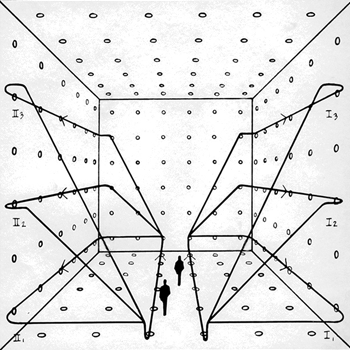We can write the original conic section in matrix form as:
#(x,y) ((1, -2),(-2 ,1)) ((x),(y)) = 1#
Or:
# (x,y) A ((x),(y)) = 1 qquad triangle#
If we could write this is the following form with a diagonal matrix #Lambda# using new rotated axes X and Y we would have no #XY# term, ie:
#(X,Y) color(blue)(((a_(11), 0),(0 ,a_(22))) ((X),(Y))) = (X,Y) color(blue)(Lambda) ((X),(Y)) = 1#
That is what we are going to do.
Firstly, for a clockwise rotation #theta # from orthogonal axes (x,y) to new orthogonal axes (X,Y), we know that:
#((x),(y)) = ((cos theta, -sin theta),(sin theta ,cos theta)) ((X),(Y)) = R((X),(Y)) qquad square#
Now, because R is orthogonal, #R^T = R^(-1)#; and because the transpose of the product of some matrices is the product of their transposes in reverse order, so we say wrt #square# that:
#(x, y) = (X,Y) R^(-1) qquad circ#
We can now re-write #triangle# using #square# and #circ# as:
# (X,Y) color(red)(R^(-1) A R)((X),(Y)) = 1#
If #R# is the matrix that diagonalises #A#, ie if #Lambda = R^(-1) A R#, then we have achieved what we set out to do :) because:
# (X,Y) color(red)(R^(-1) A R)((X),(Y)) = 1 implies (X,Y) color(red)(Lambda)((X),(Y)) = 1#
As it happens, matrix #A# is diagonalisable:
-
#lambda_1 = -1, mathbf alpha_1 = ((1),(1))#
-
#lambda_2 = 3, mathbf alpha_2 = ((-1),(1))#
The diagonal matrix is #Lambda = ((-1, 0),(0, 3))#, and the matrix of eigenvectors is #R = ((1, -1),(1, 1))# with #R^(-1) = 1/2((1, 1),(-1, 1))#
So:
#(X, Y) ((-1, 0),(0, 3)) ((X),(Y)) = 1#
or:
#-X^2 + 3Y^2 = 1#, which is a hyperbola based symmetrically about the Origin.
In terms of the rotation, we need to ensure that our #R# is orthogonal:
#Lambda = R^(-1) A R = 1/2((1, 1),(-1, 1)) ((1, -2),(-2 ,1)) ((1, -1),(1, 1)) #
#= ((1/sqrt2, 1/sqrt2),(-1/sqrt2, 1/sqrt2)) A ((1/sqrt2, -1/sqrt2),(1/sqrt2, 1/sqrt2)) #
#= ((cos (pi/4), sin (pi/4)),(-sin (pi/4), cos (pi/4))) A ((cos (pi/4), -sin (pi/4)),(sin (pi/4), cos (pi/4))) #
#implies R = ((cos (pi/4), -sin (pi/4)),(sin (pi/4), cos (pi/4))) #
So the rotation is #pi/4#


